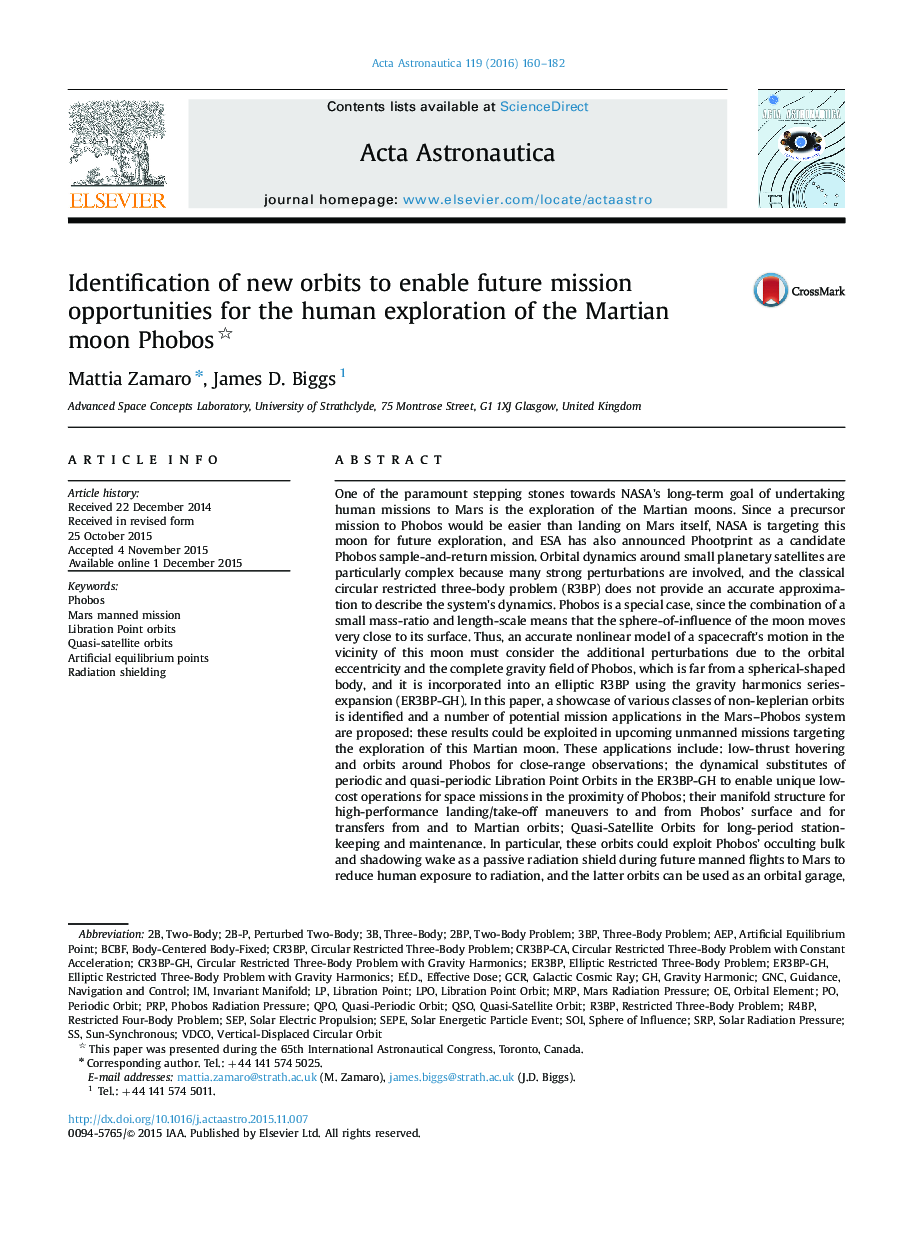| کد مقاله | کد نشریه | سال انتشار | مقاله انگلیسی | نسخه تمام متن |
|---|---|---|---|---|
| 8056372 | 1519935 | 2016 | 23 صفحه PDF | دانلود رایگان |
عنوان انگلیسی مقاله ISI
Identification of new orbits to enable future mission opportunities for the human exploration of the Martian moon Phobos
ترجمه فارسی عنوان
شناسایی مدارهای جدید برای تأمین فرصت های ماموریت آینده برای اکتشاف انسان ماه فانوس مریخ
دانلود مقاله + سفارش ترجمه
دانلود مقاله ISI انگلیسی
رایگان برای ایرانیان
کلمات کلیدی
SOI2BPGuidance, navigation and controlER3BPSphere of influenceR3BPGCRSEPMRPAEPLPOSRPPrPGNCGalactic cosmic ray - اشعه کیهانی کهکشانیCircular restricted Three-body problem - دایره ای محدود شده است مشکل سه گانهEffective dose - دوز موثرThree-body - سه بدنSolar radiation pressure - فشار تابش خورشیدیPhobos - فوبوسRadiation shielding - محافظ تابشRestricted three-body problem - محدودیت مشکل سه بدنPeriodic orbit - مدار دوره ایLibration point orbit - مدار نقاط نقطهTwo-body problem - مشکل دو بدنThree-body problem - مشکل سه بدنRestricted four-body problem - مشکل محدودیت چهار بدنInvariant manifold - منیفولد انحرافlibration point - نقطه لرزشSolar electric propulsion - نیروی برق خورشیدیLibration point orbits - چرخش نقطه چرخش
موضوعات مرتبط
مهندسی و علوم پایه
سایر رشته های مهندسی
مهندسی هوافضا
چکیده انگلیسی
One of the paramount stepping stones towards NASA׳s long-term goal of undertaking human missions to Mars is the exploration of the Martian moons. Since a precursor mission to Phobos would be easier than landing on Mars itself, NASA is targeting this moon for future exploration, and ESA has also announced Phootprint as a candidate Phobos sample-and-return mission. Orbital dynamics around small planetary satellites are particularly complex because many strong perturbations are involved, and the classical circular restricted three-body problem (R3BP) does not provide an accurate approximation to describe the system׳s dynamics. Phobos is a special case, since the combination of a small mass-ratio and length-scale means that the sphere-of-influence of the moon moves very close to its surface. Thus, an accurate nonlinear model of a spacecraft׳s motion in the vicinity of this moon must consider the additional perturbations due to the orbital eccentricity and the complete gravity field of Phobos, which is far from a spherical-shaped body, and it is incorporated into an elliptic R3BP using the gravity harmonics series-expansion (ER3BP-GH). In this paper, a showcase of various classes of non-keplerian orbits is identified and a number of potential mission applications in the Mars-Phobos system are proposed: these results could be exploited in upcoming unmanned missions targeting the exploration of this Martian moon. These applications include: low-thrust hovering and orbits around Phobos for close-range observations; the dynamical substitutes of periodic and quasi-periodic Libration Point Orbits in the ER3BP-GH to enable unique low-cost operations for space missions in the proximity of Phobos; their manifold structure for high-performance landing/take-off maneuvers to and from Phobos' surface and for transfers from and to Martian orbits; Quasi-Satellite Orbits for long-period station-keeping and maintenance. In particular, these orbits could exploit Phobos' occulting bulk and shadowing wake as a passive radiation shield during future manned flights to Mars to reduce human exposure to radiation, and the latter orbits can be used as an orbital garage, requiring no orbital maintenance, where a spacecraft could make planned pit-stops during a round-trip mission to Mars.
ناشر
Database: Elsevier - ScienceDirect (ساینس دایرکت)
Journal: Acta Astronautica - Volume 119, FebruaryâMarch 2016, Pages 160-182
Journal: Acta Astronautica - Volume 119, FebruaryâMarch 2016, Pages 160-182
نویسندگان
Mattia Zamaro, James D. Biggs,
